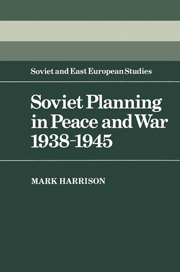Book contents
- Frontmatter
- Contents
- Dedication
- Preface
- Acknowledgements
- 1 ECONOMIC PLANNING AND THE SEARCH FOR BALANCE
- 2 THE COMING OF WAR: PLANS AND REALITIES IN 1941
- 3 THE SOVIET PRODUCTIVE EFFORT
- 4 THE SEARCH FOR ECONOMIC BALANCE IN WARTIME
- 5 SOVIET LESSONS FROM WORLD WAR II
- APPENDICES
- 1 Soviet arms production 1930–45
- 2 Soviet heavy industry output 1928–45
- 3 Soviet arms balances 1941–5
- 4 Composition of the USSR Sovnarkom 1938–45
- 5 Abbreviations and technical terms
- Bibliography
- Index
4 - Composition of the USSR Sovnarkom 1938–45
Published online by Cambridge University Press: 29 October 2009
- Frontmatter
- Contents
- Dedication
- Preface
- Acknowledgements
- 1 ECONOMIC PLANNING AND THE SEARCH FOR BALANCE
- 2 THE COMING OF WAR: PLANS AND REALITIES IN 1941
- 3 THE SOVIET PRODUCTIVE EFFORT
- 4 THE SEARCH FOR ECONOMIC BALANCE IN WARTIME
- 5 SOVIET LESSONS FROM WORLD WAR II
- APPENDICES
- 1 Soviet arms production 1930–45
- 2 Soviet heavy industry output 1928–45
- 3 Soviet arms balances 1941–5
- 4 Composition of the USSR Sovnarkom 1938–45
- 5 Abbreviations and technical terms
- Bibliography
- Index
Summary
Defining the evolution of the ministerial structure and of appointments to ministerial posts in Soviet government proved to be an unexpectedly substantial research task in its own right. There did not appear to be any one definitive listing of posts and their occupants, and the findings shown in this appendix were culled from a variety of official, biographical and scholarly sources. The results can be consulted in conjunction with the indispensable and much more comprehensive work of S. G. Wheatcroft and R. W. Davies on prominent officials in the Soviet Union before 1941.
Below are listed all USSR People's Commissariats and other posts bringing membership of the USSR Council of People's Commissars (the Sovnarkom) on 19 January 1938, and all additional commissariats and posts created between this date and the close of the Great Patriotic War. The starting date of this list relates to information given at the first session of the first USSR Supreme Soviet to be elected under the 1936 ‘Stalin’ Constitution (the term of this first Supreme Soviet was extended after the outbreak of war in 1941, and new elections were not held until 1946).
During this period there were many changes in the structure of government and in official appointments. Posts were created, abolished or renamed. Often the subdivision or merger of big bureaucracies was involved. Also associated with this was a rapid turnover of leading personnel.
- Type
- Chapter
- Information
- Soviet Planning in Peace and War, 1938–1945 , pp. 267 - 286Publisher: Cambridge University PressPrint publication year: 1985



